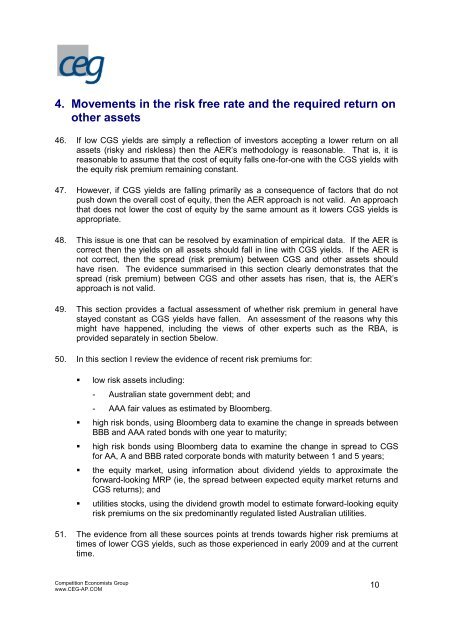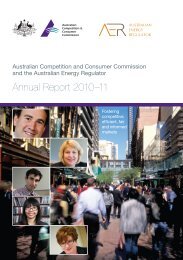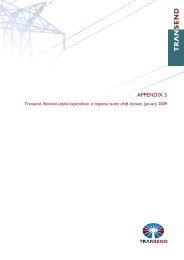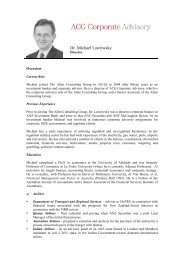Internal consistency of risk free rate and MRP in the CAPM
Internal consistency of risk free rate and MRP in the CAPM
Internal consistency of risk free rate and MRP in the CAPM
Create successful ePaper yourself
Turn your PDF publications into a flip-book with our unique Google optimized e-Paper software.
4. Movements <strong>in</strong> <strong>the</strong> <strong>risk</strong> <strong>free</strong> <strong>rate</strong> <strong>and</strong> <strong>the</strong> required return on<br />
o<strong>the</strong>r assets<br />
46. If low CGS yields are simply a reflection <strong>of</strong> <strong>in</strong>vestors accept<strong>in</strong>g a lower return on all<br />
assets (<strong>risk</strong>y <strong>and</strong> <strong>risk</strong>less) <strong>the</strong>n <strong>the</strong> AER’s methodology is reasonable. That is, it is<br />
reasonable to assume that <strong>the</strong> cost <strong>of</strong> equity falls one-for-one with <strong>the</strong> CGS yields with<br />
<strong>the</strong> equity <strong>risk</strong> premium rema<strong>in</strong><strong>in</strong>g constant.<br />
47. However, if CGS yields are fall<strong>in</strong>g primarily as a consequence <strong>of</strong> factors that do not<br />
push down <strong>the</strong> overall cost <strong>of</strong> equity, <strong>the</strong>n <strong>the</strong> AER approach is not valid. An approach<br />
that does not lower <strong>the</strong> cost <strong>of</strong> equity by <strong>the</strong> same amount as it lowers CGS yields is<br />
appropriate.<br />
48. This issue is one that can be resolved by exam<strong>in</strong>ation <strong>of</strong> empirical data. If <strong>the</strong> AER is<br />
correct <strong>the</strong>n <strong>the</strong> yields on all assets should fall <strong>in</strong> l<strong>in</strong>e with CGS yields. If <strong>the</strong> AER is<br />
not correct, <strong>the</strong>n <strong>the</strong> spread (<strong>risk</strong> premium) between CGS <strong>and</strong> o<strong>the</strong>r assets should<br />
have risen. The evidence summarised <strong>in</strong> this section clearly demonst<strong>rate</strong>s that <strong>the</strong><br />
spread (<strong>risk</strong> premium) between CGS <strong>and</strong> o<strong>the</strong>r assets has risen, that is, <strong>the</strong> AER’s<br />
approach is not valid.<br />
49. This section provides a factual assessment <strong>of</strong> whe<strong>the</strong>r <strong>risk</strong> premium <strong>in</strong> general have<br />
stayed constant as CGS yields have fallen. An assessment <strong>of</strong> <strong>the</strong> reasons why this<br />
might have happened, <strong>in</strong>clud<strong>in</strong>g <strong>the</strong> views <strong>of</strong> o<strong>the</strong>r experts such as <strong>the</strong> RBA, is<br />
provided sepa<strong>rate</strong>ly <strong>in</strong> section 5below.<br />
50. In this section I review <strong>the</strong> evidence <strong>of</strong> recent <strong>risk</strong> premiums for:<br />
� low <strong>risk</strong> assets <strong>in</strong>clud<strong>in</strong>g:<br />
Competition Economists Group<br />
www.CEG-AP.COM<br />
- Australian state government debt; <strong>and</strong><br />
- AAA fair values as estimated by Bloomberg.<br />
� high <strong>risk</strong> bonds, us<strong>in</strong>g Bloomberg data to exam<strong>in</strong>e <strong>the</strong> change <strong>in</strong> spreads between<br />
BBB <strong>and</strong> AAA <strong>rate</strong>d bonds with one year to maturity;<br />
� high <strong>risk</strong> bonds us<strong>in</strong>g Bloomberg data to exam<strong>in</strong>e <strong>the</strong> change <strong>in</strong> spread to CGS<br />
for AA, A <strong>and</strong> BBB <strong>rate</strong>d corpo<strong>rate</strong> bonds with maturity between 1 <strong>and</strong> 5 years;<br />
� <strong>the</strong> equity market, us<strong>in</strong>g <strong>in</strong>formation about dividend yields to approximate <strong>the</strong><br />
forward-look<strong>in</strong>g <strong>MRP</strong> (ie, <strong>the</strong> spread between expected equity market returns <strong>and</strong><br />
CGS returns); <strong>and</strong><br />
� utilities stocks, us<strong>in</strong>g <strong>the</strong> dividend growth model to estimate forward-look<strong>in</strong>g equity<br />
<strong>risk</strong> premiums on <strong>the</strong> six predom<strong>in</strong>antly regulated listed Australian utilities.<br />
51. The evidence from all <strong>the</strong>se sources po<strong>in</strong>ts at trends towards higher <strong>risk</strong> premiums at<br />
times <strong>of</strong> lower CGS yields, such as those experienced <strong>in</strong> early 2009 <strong>and</strong> at <strong>the</strong> current<br />
time.<br />
10







